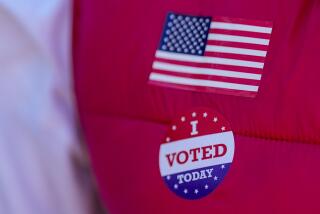Nasty Campaigns Are With Us for Awhile
- Share via
If there was a theme to this year’s midterm elections, it was that any substantive messages were drowned out by the relentlessly negative tone of campaigns on both sides, for all offices, across the country.
We had candidates excoriated for missing votes--not showing up for work, that is--for voting against God, motherhood, apple pie and Social Security, for being chronic drunks, embezzling funds, not filing income-tax returns, and for being anti-male (read, lesbian) or homosexual pedophilic.
Voters, reporters, political pros and editorial writers are all understandably appalled by this. But it is important to put the negative campaigning into the proper perspective--we won’t find any way to change the tone of campaigning otherwise. Basically, there are several axioms that must be stated first:
Negative campaigns are not new. It will not make anybody feel any better, but the fact is that there is a 150- or 200-year tradition of negative campaigning in American politics, and it has often been as gamy as it was this year. Sexual peccadilloes, drinking habits and other personal characteristics have been raised before. Remember “Ma, Ma, where’s my Pa? Gone to the White House, ha, ha, ha”? That was the slogan raised by Grover Cleveland’s opponents to highlight the rumors of his having fathered an illegitimate child. We have seen records grossly misrepresented, candidate intelligence impugned, candidate personal characteristics such as weight or amount of hair ridiculed. So what is new now?
The basic difference is television. When charges are raised in a flood of 30-second spots over and over, saturating the airwaves, and when the spots themselves became the major focus of the news coverage on television and in the print press, both the reach and the penetration of the negative messages expand enormously. And this campaign year, in small states and large, from the Dakotas to California, the campaigns have been television wars. Retail campaigning--rallies, face-to-face encounters--has been pushed so far into the background that it is barely visible. And the TV messages are graphically negative.
Negative campaigns work. This, unfortunately, may be the key axiom. Politicians are not naturally vicious, venal and low. Like anybody else involved in a campaign to sell something or somebody, they will use what works and discard what flops. And no pious candidate who pledges to avoid negative campaigns will do so if he or she thinks that this decision will cost the election. The sad reality is that candidates turned negative this year because negative works--the public responds. And where negative doesn’t work --as in, for example, the Vermont Senate race, where attacks on incumbent Sen. Patrick Leahy boomeranged on the attacker, former Gov. Richard Snelling, they were promptly dropped.
Negative ads fill a vacuum . We saw more negative ads this year because there were no dominant issues that truly had a grip on the public. Every recent survey that asked the American electorate the standard question, “What is the biggest problem facing America?” received similar responses--no single issue grips more than 10% of the electorate. If there are no issues to dominate, candidate personalities dominate. Why, then, don’t candidates simply accentuate their own positive personalities and characters? The answer is that often the only way for a challenger to differentiate himself or herself from the current officeholder is to make negative comparisons. Incumbents have in turn learned, through bitter experience, that ignoring attacks can be fatal. Thus, attack breeds counterattack.
There are a few things that could be done to dampen the negative trend in campaigns, but precious few. Disillusioned political media expert Charles Guggenheim has suggested, creatively, that we eliminate 15- and 30-second spots on television and make the minimum political commercial two minutes--that in two minutes one either has to be positive or provide ample evidence for a negative charge. While the suggestion is creative, it is also questionable. Any move by government to regulate advertising in campaigns could easily set a precedent for more government involvement than a free election-based democracy would want. Probably the best hope is that reporters, especially television reporters, become more aggressive in uncovering, highlighting and pinpointing dubious and scurrilous claims. We cannot rely on claim and counterclaim to force out the truth--at least not before an election.
Unfortunately, we are basically going to have to hope that issues arise that crowd out negative campaigns; that voters get so turned off by the attacks that they start to backfire; that we find ample examples where negative campaigns don’t work, and that the campaign experts start to use other techniques. But these developments will not come soon, if they come at all. That negative campaigns are traditional American politics, that they are used because they work and because there are no big issues to make them unnecessary may come as scant comfort to a turned-off electorate. But there is little additional comfort out there to provide.
More to Read
Get the L.A. Times Politics newsletter
Deeply reported insights into legislation, politics and policy from Sacramento, Washington and beyond. In your inbox twice per week.
You may occasionally receive promotional content from the Los Angeles Times.










